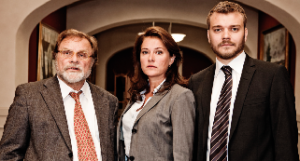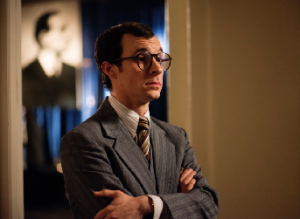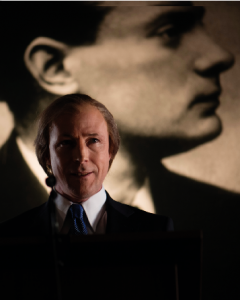Charlie
Published in Issue 2 (March/April 2015), Reviews, Volume 23Charles J. Haughey did not come cheap. Neither did this much-hyped three-part mini-series on the life, or excerpts thereof, of the notorious former taoiseach, which apparently cost €4 million to produce. Yet the expensive production costs of Charlie seem to have been lost as it made its way to the small screen. So too, alas, was a sense of drama, or some of the other basic requirements that ought to induce a viewer to watch nearly five hours of television over three Sunday nights. What we got was a dull and disappointing mini-series, broken down into three episodes, each dealing with a different period of Haughey’s political career in an interchangeable way.
The three periods were his accession to the leadership of Fianna Fáil in 1979; his first term as taoiseach in 1981–2; and his final term, leading up to his resignation in 1992. Within that structure there was ample scope for a gripping story to be told, but that potential was largely squandered. Charlie wasted numerous dramatic opportunities in inexplicable ways. Why, for instance, did it choose to depict François Mitterand—most notably in a truly ludicrous (and seemingly plagiarised) scene involving the eating of a fowl—while declining the opportunity to depict Haughey’s often-tetchy relationship with Margaret Thatcher? Charlie perpetuated a narrow vision of the career of the man it claimed was the ‘black prince’ of Irish politics, with the action, such as it was, largely confined to ostensibly tense meetings of TDs in various dimly lit rooms. In political terms, this re-sembled the politics of a students’ union, with no discernible sense of ideology or of the country that Haughey ruled. A token shopkeeper, ‘Jacinta’, seemed to represent the plain people of Ireland, whose favour was purchased at one point with gifts of hams to the people, in the style of a chieftain of old. Aidan Gillen made a good fist of capturing Haughey’s mannerisms, but all too often talented actors such as Tom Vaughan-Lawlor (who played P.J. Mara) seemed to be impersonating their subjects rather than bringing them to life as dramatic creations in their own right. It is not good enough to have the correct suits and hairstyles: this never felt like it existed as a drama on its own terms (there is an interesting comparison to be made with the recent TV3 production The Guarantee). Matters were not helped by an irksome use of extended exposition: the quality of conversation in Ireland seems to have declined since the 1980s, when people apparently gave mini-lectures on a variety of political and economic issues. It made for clunky, stilted TV.

Prime Minister Birgitte Nyborg (Sidse Babett Knudsen) in Borgen, which had rounded characters; the depictions of some individuals in Charlie often seemed little more than caricatures.
That said, the approach taken by Charlie begs two questions. How does one breathe life into fictionalised depictions of actual events? And what can we really say about Charles J. Haughey and his time? With regards to the first, in 1989 Joe Lee’s Ireland 1912–1985 put forth the contentious proposition that Ireland had underperformed relative to the other small European countries that were its natural peers. Denmark was one of these, and in more recent time Danish TV has produced a very impressive and engaging political drama in the form of Borgen. Yet the cast of Borgen had rounded characters with which to work; the depictions of some individuals in Charlie often seemed little more than caricatures. Surely a drama of this kind has to stand on its own two feet and to render a believable world that, even if it is intended to be a depiction of reality, remains coherent and credible in and of itself. Charlie did not do this. One got the sense that it was made in a self-conscious, knowing manner, and depended upon the audience knowing in advance what was going on; a breach of the fourth wall never seemed to be too far away. Indeed, some of the most positive reviews came from veteran journalists such as Peter Murtagh and Stephen Collins. But were they simply be-dazzled by any rendering of events that they would have witnessed? It would be an interesting exercise to compare the commentaries of many Irish journalists with their contemporary reporting on Haughey; based on what we now know, most of them missed a few things at the time.

Talented actors such as Tom Vaughan-Lawlor (P.J. Mara) seemed to be impersonating their subjects rather than bringing them to life as dramatic creations in their own right. (RTÉ Stills Library)
The focus of Charlie remained narrowly political. It has been suggested that the Arms Trial might have been a better starting point from which to plot the trajectory of Haughey’s career. Another option might have been the relentless grind of meetings that Haughey embarked on throughout the 1970s across the country, as he slowly but surely rehabilitated himself. That would also have brought the drama, such as it was, out of the committee room. And that narrow focus bespeaks an assumption that the team behind Charlie seem to have made: that he was interested in little more than power for its own sake and that he was, essentially, a hollow man. But is this to do Haughey a disservice? He has become synonymous with corruption on a grand scale, and for that he is justifiably castigated. Yet glance further back into his early career, prior to the Arms Trial, and one can find a progressive and capable politician of considerable ability. And that brings us to the second question: how did he fit into twentieth-century Ireland? Haughey was one of the original men in the mohair suits (although he would later claim never to have worn one). He was not the first Irish politician to take a dubious payment—even Parnell seems to have done that—but was he the font of the corruption that, for many, is emblematic of Irish political life? The Flood and Mahon tribunals devoted inordinate time to planning corruption in north County Dublin; was it a coincidence that this was Haughey’s territory? Was he really the ‘cancer’ in the body politic that Dick Spring spoke of in 1992? Or did he simply operate within a corrupt political culture, while taking its excesses to a new level? Haughey remains divisive, for understandable reasons, but in any accounting of his legacy Charlie might have more to say about certain perceptions of its subject than about the reality.
John Gibney is editor of www.decadeofcentenaries.com.

















